Photography courtesy of Lowell Washburn, all rights reserved.
Common Wetland Resident Provides Uncommon Opportunity for Bird Study
Many of my most interesting wildlife encounters have occurred as complete surprises rather than carefully planned activities. A good example began while birding the shallow margins of a local cattail marsh.
I was hoping to photograph newly hatched broods of baby wood ducks when I noticed a female red-winged blackbird nervously flitting among the reeds. Nothing unusual in sighting a red-wing, they’re one of Iowa’s most common bird species. But this female was different; appearing to be somewhat anxious and extremely focused. After keeping an eye on the bird, I began to wonder if she wasn’t looking for a place to build a nest. My suspicions were soon confirmed when the red-wing pulled a beak full of soggy grasses from the wetland’s oozy surface. Lifting her cargo into the air, the female flew about 20 yards before suddenly diving back into the standing vegetation. The bird reemerged, flew back toward the shoreline, and then quickly returned with another load of wet vegetation. Making the most of this unusual opportunity, I slowly crept ever closer until in position to view the red-wing’s life history – literally from the ground up.
Working more or less nonstop, it took the female red-wing two days to complete her hanging, basket shaped nest. The task would have been finished even sooner had not the female chosen to inspect, test, and then reject a good percentage of the nesting material she considered. The nest was barely completed before the first of three, blue mottled eggs was deposited in the tightly woven, still drying, ever shrinking structure. The nest was faithfully guarded and all three eggs hatched during the 11th and 12th days of incubation. All three youngsters successfully fledged from the nest thirteen days after hatching.
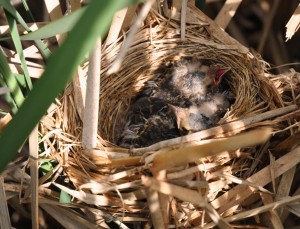
Although ever present, the male did little – nothing actually – to assist with nest construction or care of the young. Instead, the male devoted every waking minute to displaying the finery of his red and orange shoulder plumage while singing the species’ familiar trill. The male vigorously defended the invisible lines of his territory from rival males, but then left the protection of nest and growing young entirely to the female. The female rose to the occasion; boldly defending the nest site against all potential threats but never more vehemently than whenever a passing crow ventured near.
A notable exception to the male’s seemingly disengaged behavior occurred early one morning when a family of giant Canada geese unknowingly invaded the red-wing’s domain. Launching a vicious attack, the male pounded the gander with a merciless series of hawk-like stoops. In spite of their tremendous size advantage, the geese took the attack seriously. Circling the wagons, the adults herded the goslings into a tight ball. The Canadas beat a hasty retreat and the male red-wing quickly resumed his egotistical displays.

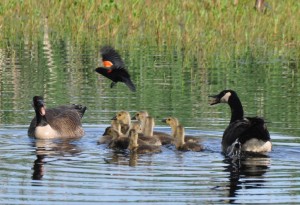
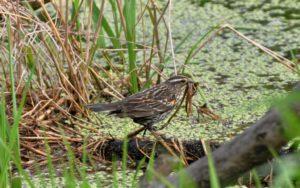
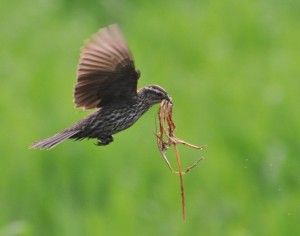
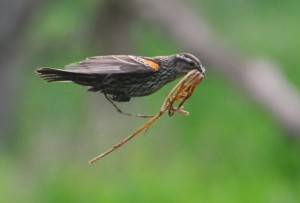
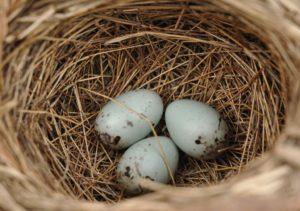
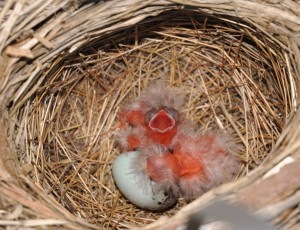
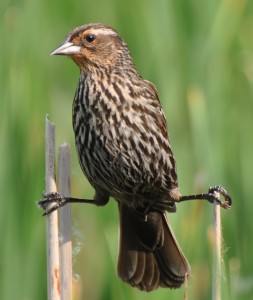
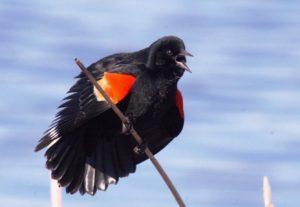
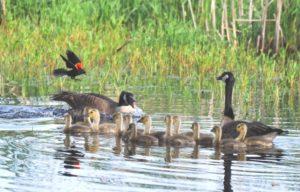
 Susan Judkins Josten
Susan Judkins Josten Rudi Roeslein
Rudi Roeslein Elyssa McFarland
Elyssa McFarland Mark Langgin
Mark Langgin Adam Janke
Adam Janke Joe Henry
Joe Henry Sue Wilkinson
Sue Wilkinson Tom Cope
Tom Cope Kristin Ashenbrenner
Kristin Ashenbrenner Joe Wilkinson
Joe Wilkinson Dr. Tammy Mildenstein
Dr. Tammy Mildenstein Sean McMahon
Sean McMahon